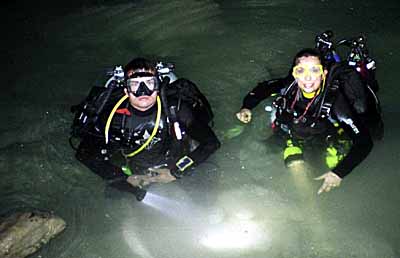 |
By Chris Killey, with contributions from Greg Gregory, Shayne Stewart, and Arlene Foss.
Updated, September, 2013
December 25, 2002 – it’s 2pm in Dhahran. Greg’s Landcruiser is loaded to the gunnels – there’s everything except the kitchen sink (but later, we find that the sterile water sample containers didn’t make it either.)
Shayne calls on his mobile from Gate #6 – he’s ready and waiting to go. We climb aboard the Landcruiser and head for Gate #6. The Security Guard wants to know where we’re going with all the gear and then offers his best wishes for the journey, sends us on our way…. But wait, we missed the turnoff to the Guard House where Shayne will be waiting…… So down to the traffic lights and another U-turn back across the traffic – nothing new about that, but the Guard tells us he wants to issue a violation and then laughs and sends us off again.
Good to meet Shayne Stewart - he’s driving a big Ford Expedition wagon, and carrying his optimized caving dive gear for the Ain Hit expedition. Shayne has completed rigorous cave diving certification training, and has participated in numerous cave dives.
We’re excited with anticipation about the trip and delighted to finally be on the road, Shayne following in convoy – out through the tangle of roads from Dhahran until we hit the highway south.
We have a 4-hour drive ahead of us to Riyadh - our plan is to stay the night in the city at the Willmott family villa, long-time British friends. We’ll head out to Ain Hit the next morning and meet Lars Bjurström & Arlene Foss there at 9am, and camp out Thursday night at the site.
After an hour or so, we pull into a gas station/truck stop to stretch our legs and look for some firewood for our camp-out. The old style truck-stops along the way are being replaced by new generic design buildings, freshly painted and lacking character. Greg gives the men’s toilet a ‘C’ rating…. Not bad…. They’re definitely an improvement on some of the old ones, and there are proper Hammams for ladies too!
Nothing much to buy here in the tiny shop. I miss the dusty stores that used to surround the old gas stations, they were full of obscure things for sale, army-style sun hats, aluminum platters, thongs, talking toy parrots, fake Rolex watches, Bisht coats, coffee flasks etc. Maybe we’ll find one further along the highway…
We head off again for another hour or so – past big trundling cargo trucks with Yemeni style paintwork, and Toyota Pick-up trucks stacked with young camels –heads aloof and graceful in the wind. Shiny Lexus’, Caprices’, Mercedes’, and GM’s zoom past us in three lanes, disappearing in a flash down the stretched grey tarseal to the horizon.
Occasional camel herds wander in the sands beyond the highway fence – one ambles through a gap and heads toward the road. We drive on, wondering more than a few things about its fate….
It’s 4.30pm. My finger measure says there’s about 35 minutes of sunlight left. Hold your hand to the sun at arm’s length, fingers together and palm facing you. Measure how many fingers between the sun and the horizon – formula is ten minutes per finger. Greg doesn’t believe it. Thirty-five minutes later the sun goes down – we watch for the green flash, but a big truck gets in the way right at the crucial moment.
It’s getting dark, and we spot another gas-station truck stop lit up ahead – a larger complex – a few more stores, and some firewood bundles stacked outside. SR20 per bundle says the man, smiling…. No negotiations here…..! We take two bundles, and a couple of loose bits for good measure….. and stack them onto the floor of Shayne’s wagon. The Ladies toilet gets a ‘B minus‘. Men’s a ‘B’.
Back on the road and plenty of headlights snaking in the distance. After a while the glow of Riyadh appears in the night sky – over the top of a rise and the city is glittering across the horizon. The traffic gets crazier as we get closer. We’re looking for signs to the City Center, and Exit 13 – but all the signs are in Arabic! We take the only one in English - "Diplomatic Quarter" and by luck it takes us past the Sheraton in the direction of Olaya, Sulaimaniya and the impressive Faisaleer tower building…. We duck through some slip roads, four-lane traffic lights, and swing into Thalateen Street to look for the Turkish Restaurant. The road is jammed with traffic and vehicles double-parked, but our luck is still with us - two parking spaces free outside the restaurant.
Throw on an Abaya for this - time to take a break and have some food. Our seasonal dinner is in the "family section" of Assaraya Turkish Restaurant. Plenty of it, sizzling and tasty: Tabouleh, Baba Ganoush, Hommus, and a big fat holey slab of hot bread. A good time to catch up with Shayne’s journey. We use his mobile and call the Willmott’s, let them know we’re almost there.
Their villa is a few minutes from the Restaurant, down some back streets. We ring the bell and that launches their five dogs into a barking cacophony on the other side of the heavy iron gate….. I warn about Josh, the big desert saluki-cross – he’s been known to bite strangers sometimes…. The family greet us warmly and welcome us into their home, as do the dogs - Josh, fat Bessie, Suzy, Bella and Pogo, with much panting, jumping, sniffing and tail wagging.
We enter the magical world of the Willmott villa – it’s alive with dazzling color and the aftermath of a rich holiday celebration…. amid a world of creativity, musical instruments, and artwork. It’s sumptuously both chaotic and ordered.
It’s wonderful to be there after the long day. We relax into the endless round of cups of tea and catch up on everyone’s news. Presently, we’re taken on the ‘house tour’ – to the villa across the road where Greg and Shayne will stay. We unload some gear inside. It’s getting late – bid goodnight - time to get some sleep for an early start tomorrow.
It’s Thursday morning 6am and I creep around the sleeping Willmott household - pack up and fill the thermos flask for later. Take some toast across the road to Greg & Shayne. They’re organized to go… A clear blue sky beckons us.
Following Lars’ instructions and my fading memory of the Ain Hit route, we wind thru the city past the bizarre Ministry of Interior building – architecturally fascinating spaceship-shaped office structure. The Al Kharj signs lead us out of the city and the buildings drop away behind us. Half and hour and the escarpment comes into view, and finally the "Heet" sign - YES!
The track to Ayn Hit, showing the small abandoned building and the steep cliff face above the entrance, shadowed by the afternoon sun.
|
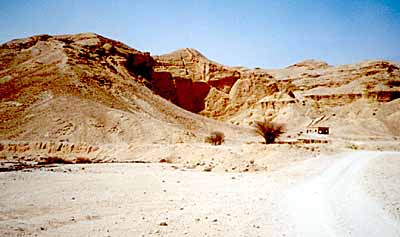 |
We turn off the highway over the railway line and onto some gravel, the hills getting closer, and we snake around some tracks till we spot the old brick building landmark in the foothills. Graffiti! Around it and down to the magnificent cave entrance – it’s awesome and scary all at once.
| It’s a
huge open cavern at the base of a high vertical cliff, leading down a
rocky breakdown slope to a slit of blackness....
|
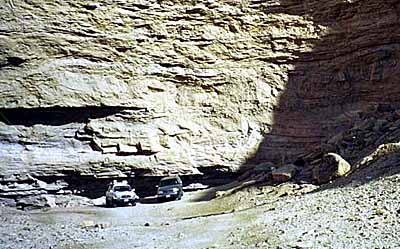 |
...A further 50 meters down, some big boulder landslides lie on either side of the entrance. We park the vehicles at the lip and peer down into the dark interior.
From our relatively flat vantage point at the lip above the cave, we have a captivating panorama: the sheer bedded cliffs surrounding us on 3 sides; Scanning our present surroundings, we try to imagine the activity that has played-out over the years at this ancient watering hole. As recently as 20 years ago, we would have been viewing the clear waters at a level not far below our vantage point – hence its name Ain Hit – Ain meaning spring.
We have heard the fond remembrance of our middle-aged co-workers who visited and swam in the spring waters during their youth. In earlier times, Ain Hit served as a camel caravan watering hole, having been used by King Abdulaziz.
Ain Hit is a key outcrop location site where early exploration geologists gained an understanding of important Eastern Province sedimentary rock formations. Ain Hit is the type locality of the Hith Formation; the hard, dense, layered anhydride and carbonate beds of this formation make up most of the dahl Hit cave roof and cave walls. Just above the Hit is the younger Soulay Formation, the carbonate rocks of which make up the steep cliffs surrounding us.
|
|
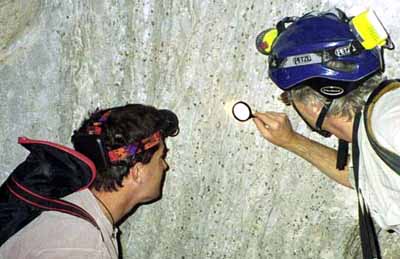 |
And beneath the Hith in the deepest and submerged portions of dahl Hit is the Jurassic-age Arab carbonate formation. Most of Saudi Arabia’s oil is found in porous layers of the Arab formation, and the oil has been trapped there for millions of years due to the presence of the overlying impermeable Hith anhydrite beds. It has been suggested that visits by early geologists to Ain Hit may have provided the insight for them to drill to these formations at their subsurface locations 200km to the east at Abqaiq and Ghawar.
It is only in the most recent times that intense usage of Arab formation ground water has caused the water table to plummet, with Ain Hit’s water level disappearing far into the darkest reaches of the cave. Surveying just how far down is one of the goals of our weekend trip.
Testing the initial track down the gravelly rocky slope, we come to the first massive heap of boulders spread across the path. Checking out the cave roof entrance– there are big chunks missing overhead, and the fallout looks fairly recent.
Greg and Shayne pick their way over and down into the cave and say it feels safer further in. Decision to return topside, gather up some gear and go deeper in. Returning to the vehicles and sunshine, suddenly we hear an awesome rumble coming from deep in the cave – it’s startling – like a huge rock slide. We glance nervously at each other… there’s been heavy rain here in the last two weeks… anything could be happening down under with slips etc……. Many rumbles later we realize it’s the cave echoing the noise of vehicles approaching from the road.
Lars Bjurström and Arlene Foss drive up. Lars and Arlene both live and work in Riyadh, and have dived Ain Hit previously, Arlene having clocked up over 30 dives there in 1995-97 with NSS Caver Diver Mike Gibson. It’s good to meet them at last – their reputation in diving and experience of the cave has preceded them. Arlene hasn’t visited the cave for a couple of years and is surprised at the amount of breakdown since. Lars must return to Riyadh shortly, but offers to help hustle some of the gear down to the mouth of the cave. For reference and review, everyone gathered around a 3D block diagram of Ain Hit from the ’97 Aramco World "Diving in the Desert" article by Lar’s twin brother Erik. Aspects of the underwater passages were discussed, as well as Lars and Erik’s experience in requesting permission to visit the large sinkholes near Al Kharj. These large sinkholes used to have water near the ground level, whereas the level is now about 250’ beneath the surface. We agreed that an effort to abseil and survey the water holes would be an excellent project to do jointly with the Saudi Geological Survey (SGS).
|
|
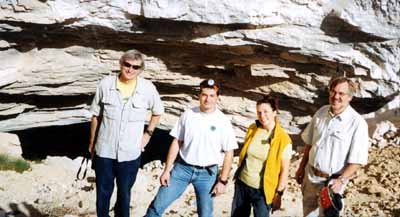 |
In assessing their gear transport options, Shayne chose to shoulder his fully assembled twin tanks, whereas Greg opted to bring down 1 tank at a time; Arlene and Lars help bring the other dive and photo support gear in large caving backpacks.
Loaded up, they all head down into the cave. I stay topside to keep an eye on the vehicles and equipment. My last visit here was 18 months ago and I see with dismay an increase in the graffiti on the rocks and extensive rubbish lying around everywhere. It’s become a popular spot for sightseers, but disappointingly there seems to be no regard for the environment here.
After scrambling down the crumbly steep slope and entering the large, shadowed part of the cave, Lars passed the gear he has helped carry on to Arlene, returns back up-slope, and then is off back to Riyadh. He is working hard on a project of photographing Ancient Rock Art in the Kingdom, and specifically a significant recent discovery in the Hail area. An exhibition of his photographs is soon to be shown in Riyadh, and later in Dammam in the coming months, complementing his recent Aramco World Magazine Rock Art article.
Arlene, Shayne, and Greg continued scrambling down over the precarious rocky slope in the dimming light under the cave roof, until reaching a steep ledge with a 20’ (6m) drop. Arlene pointed out the two hidden and steep route options to the right of the ledge. After turning on their helmet lamps, they carefully down-climbed the cracks between the choke of giant rock boulders and slabs. A few minutes later, the zig-zag route around the truck-sized boulders and across gaping crevices lead to another exposed ledge which had to be carefully down-climbed. After a few more minutes of scrambling down the rocky slope, the group finally caught sight of the calm, clear waters. They found some convenient flat areas near the water’s edge to set down the tanks and rinsed the fine anhydrite dust off their hands and faces, taking care not to stir up the shallow water. The cool, sweet water felt refreshing, after the arduous passage down. Arlene notes that the water level is noticeably lower than when she last dove in ’97. She recognized the route to the underwater tunnel, and submerged passages beyond.
Starting off on the return route, Arlene led the way, followed by Shayne, with Greg lagging behind, getting some pictures. Minutes later, Greg looked up to see Shayne take a long, rolling tumble from the first exposed ledge climb, rolling down across the steep, sloping rock piles, until he finally came to an abrupt stop. Apparently he lost his grip or footing on the side of the slippery anhydrite-dust-coated ledge. Shayne received some significant abrasions, particularly on his lower back, but he was very fortunate that this didn’t happen while climbing down when he was heavily laden, as such a fall could have caused serious harm to to his dive gear…
After an hour or so they re-appear from the depths and trudge back up. They are impressed with the cave, and are encouraged that the diving conditions appear favorable. Shayne’s wounds are cleaned and bandaged.
Caving by itself requires plenty of essential safety equipment and Ain Hit is no exception. She’s a hard-hat area and this trip is compounded by the enormous amount of extra gear needed for underwater cave diving. They load up the rest of the equipment--- BCD’s, regulators, tank, suits, weight belts, fins, masks, underwater torches & cameras, reels of caving navigation line, headlamps, spare batteries galore, drinking water, etc. Besides that, they are kitted out with torch helmets and gloves for scaling the boulders on the way down. The base of the cave meanders through some twisty-turny boulders jutting out all over and the occasional eight-foot-high monster, circumnavigated by footholds and gravel slides. At least there’s no belly-crawling in this cave, but fitness and some nimble footwork are pre-requisite…
Around 1:00 pm they lumber off down the rocks, ladened-up, and I’m left alone at the lip as keeper of the keys, and general lookout person. It’s a magical day, clear blue sky, crisp and cool. I sit and watch them becoming smaller and smaller down the cave, finally disappearing into the blackness. The cave is awesome, huge and scary. I’m stunned by its magnificence, but now have time to observe the flagrant disregard shown it by visitors. Trash litters the ground all around, soda cans, bits of plastic, etc. I make an attempt to clean up and fill some rubbish bags with trash. We’ll haul it away when we leave and dispose of it properly somewhere on the way home.
I take a break and I lie down on the big ground mat next to the vehicles, staring straight up the 200ft+ (61m) vertical cliff above the cave entrance into the clear blue sky. It’s awesome! Little birds nest under the cave roof – they float way up on the updrafts and glide around and around, gently banking and swerving 'til they catch the right breeze. Then make a radical vertical dive down into the cave with a startling hissing sound as they swoop past.
Small flocks of pigeons perform magnificent group flight maneuvers 'way above the cliff top, in perfect formation. It’s dazzling and mesmerizing, the occasional white cloud drifts by, and then a hawk glides round and round and round, ’way up high above. I doze off into a strange dream of falling into a crevice somewhere…..
After a while, I’m woken by the deep rumbling noise again echoing out from the cave. A vehicle approaches from the road. It’s the beginning of an endless stream of sightseers over the next 3 hours. The first is a group of young Saudi men, out for a look-see. We all sit on rocks and try out our English and Arabic. There’s lots of laughing - they’re from Riyadh and Asir.
The second group is a Saudi family, including two women fully veiled. We greet, the three children shy and nervous at the sight of the awesome cave. Their father beckons them to come further down. They shriek and run back to their mother, clinging to her abaya.
A couple more cars come and go. Then a group of three Saudi men arrive, one is elderly and greybeard. He’s helped by another younger man. He says that as a child, he came here to swim in the water which leveled at the cave entrance not far from where we sit. He’s at least 70 years plus.
Another group of eight men drive up and sit in a circle on the mat for a while – discussing the pros and cons of Ain Hit – enjoying the gentle afternoon sun. They’re staying at a nearby village in some weekend units and invite us there for tea when we leave. Says not to camp just here because snakes live under the boulders and come out at night….! Gives me his email address and asks for some cave photographs.
Close to 5pm and the sun is disappearing - a niggle of worry starts. No sign of the divers. In my mind I run through a scenario of action to take in the event of a caving accident. It’s getting dark and everybody drifts away.
Suddenly Greg appears, trudging up, then Shayne, and Arlene – they have left their gear stowed down at the water for the dive tomorrow. They are excited and relieved that that the dive was successful, and are delighted to see the beautiful bright moon and stars lighting their way out of the cave. They take some refreshments at the vehicles, and fill me in on their explorations.
Following their second hike down, they proceeded to set-up and test their twin-tank cave-diving gear. They also tried to find the best way to enter the water which would minimize disturbance to the fine anhydrite silt that covered the bottom. This proved to be a daunting, nearly impossible challenge. After carefully donning their heavy gear, and testing their regs and lights, they teetered and stumbled across uneven, silty rocky shallows to get to the deeper water where they could float above the silt. Some of the shallow area silt was stirred up each time in the process, and floated like an expanding cloud, out over the deeper water, reducing visibility down to less than 2 feet (60cm) in some areas. Shane had an extremely bright custom dive light to help light the way. In addition to lights and a reel, Greg also had his camera with flash to manage and look-after. Shane and Greg briefly reviewed their dive plan, then deflated their BCD’s and slowly submerged, achieving nearly neutral buoyancy. They made their way to a narrow and low, down-sloping tunnel, which was the only route to the more distant rooms and passages. Shane led the way through, which was also marked by a single, thin white nylon navigation line. There was no way for them to avoid stirring-up the silt which coated that narrow passage, and care had to be taken to avoid snagging on the guide line, and bumping the low ceiling with the first stage regulators at the top of the tanks.
After making their way through the narrow passage, they arrived at the south end of a large open room. Greg secured a small light on the dive line at the juncture of the passage and open room to aid finding their only way back. In the open room the navigation line was tied around a prominent rock jutting down from the ceiling, and then continued on to the NNE. Greg signaled/waved "bye-bye" to Shayne, indicating that Shayne should proceed with exploring deeper into the passages, without waiting for Greg to follow. Greg had a couple of concerns, which he wanted to assess before venturing much further:
Greg also tried to discern the degree to which the murky conditions were improving. It appeared that within 15 to 20 minutes there was some notable improvement. He took a few pictures of areas that had adequate clarity, before he carefully made his way back towards the tunnel.
|
|
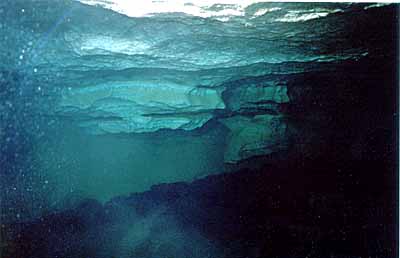 |
Meanwhile, Shayne proceeded to explore the most distant accessible reaches of the system, encountering very good visibility in the undisturbed areas.
He noted that the first large room deepened near the middle, and that there was at least one side passage to the SE; The navigation line was secured to a couple of jutting boulders along the route; Eventually the rope was secured at an inverted triangle protruding from the roof. An American flag had been secured on the south side, and a slate for "visitor registration" was tied off on the north side of the protrusion. (Pictures of this feature can be viewed at the NSS/CDS website) The open area beneath this point is the deepest visited portion of the cave, with a depth of 61 feet (18.89m) for 2002; It is at this point that Arlene was reading 78 feet (38m) on her depth gage back in’97, indicating that the water level has dropped an additional 17 feet (5.2m) in the last 5 years.
Shayne continued exploring a main tunnel branch which extended to the NNE for about 60 feet (18.59m). Eventually this tunnel, like several others, became too narrow for exploring while wearing the back-mounted tanks. On their next visit, they intend to set-up side-mount configuration for their tanks, to facilitate greater access to the narrower passages.
Shayne also noted a smaller branch trending NNW, at the northern end of the system.
After signing the log, Shayne continued back, and briefly traversed the small branch that he saw trending SSW. The passage narrowed before he could get very far, and he returned back to the main route, and eventually made his way back to the starting point.
Greg had returned about 15 minutes earlier, and took some additional pictures of Shayne as he surfaced from the tunnel.
|
|
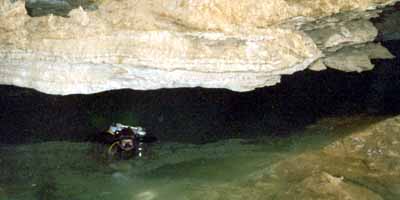 |
Shayne and Greg were both very satisfied with the dives; Shayne noted that he was also chilled, despite having a 7mm wetsuit! They dried-off, tried to warm-up, tidied up the gear, and made for the surface.
We moved the vehicles back 50 yards to a flat area in the lee of the hill and got the fire going for fried squeaky (Haloumi) cheese, some delicious homemade turkey soup from Arlene, steaks and other delicious morsels. The night air is cool; Arlene and I have brought Bishts (Bisht Farwah, sheepskin-lined cloak) – perfect desert fashion. We all swap some stories and rest up awhile.
Around 10pm Greg and I start the cave survey, using the brick building as a starting point and measuring by laser beam (Disto digital distance-measuring laser, SmartTool digital dip-meter, and Suunto analog compass). We work our way to the cave and down, selecting a survey station approx every 15 metres. I have a roll of paper towels stuffed down my jacket and a marker pen to write each station number on a paper towel – anchor it to a rock and stand there while Greg directs the laser beam to measure the distance, inclination, and declination. It’s high integrity, he said! An hour later we’ve only just reached the cave entrance and I’m starting to wonder why I volunteered for this...
We lose sight of the starry sky, and my helmet light suddenly snuffs! It’s pitch black. I hope there are no snakes! I tie the back-up light on my helmet and keep going, beneath the unstable roof overhang – five minutes seems like hours at that station!
Around 2am we reach the water level and Station #28...
A portion of the map. To see the rest of it, just click on the picture. |
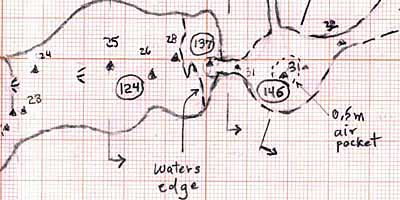 |
...Finally we can collapse! The water is clear, and feels good for rinsing the dust off our hands. The floury silt kicked up from the earlier diving has already settled back to the bottom. We turn the lights off - the blackness is more than inky… it’s almost tangible, like soft velvet on skin – it wraps itself around my senses and melts into me...
...We replenish the torches with some fresh batteries and start the climb back up. At last, the cave entrance appears ’way up high, the stars glittering through the gash. It takes us another 20 minutes to climb back out.
About 3am I collapse into my sleeping bag and into a heavy slumber, with yet another strange dream of being pulled along a ledge somewhere on a fragile rope…
Up early by 7am, awoken by the sharp crack! of firewood being broken and hacked apart--- they’re raring to go again – we re-kindle the fire, have some breakfast. A Toyota pickup trundles past toward the cave and disappears behind the ridge. Five minutes later a couple of shots ring out, echoing, birds fly off and scatter all over. We wonder out-loud about the effect on the cave stability……
The truck returns and parks by the brick building – the driver, with a gun, climbs up a nearby hill – we keep a nervous eye on him until he disappears. A couple more shots ring out, then silence and eventually we see the Toyota drive away. We pack up the camp and drive back to the entrance. By 10am they’re heading back down into the depths.
I get the mat out, sort out some of the equipment and tidy up in anticipation of the social round of sightseers. The rumbling again – the young Saudi men from yesterday return and chat. Then three Saudi military men arrive and purposefully stride off down the cave without speaking. I wonder then if we could have needed diving permits for Ain Hit? Half an hour later they climb out, stride past and drive off, saying nothing.
I continue with the rubbish collection, and then do a bit of fossil hunting – shells embedded in the broken boulders.
...They stay awhile, and then abruptly leave when the coffee is finished.
Many more visitors showed up to view the entrance throughout the day. During the morning descent down, Shayne worked to compose a number of pictures, including some with timing exposures and a 2nd strobe. Many of then them turned out quite nice:
|
|
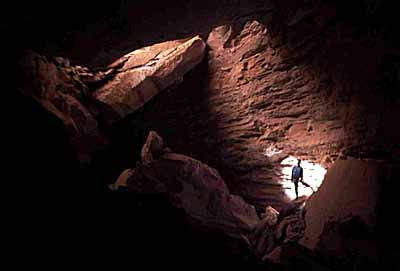 |
|
|
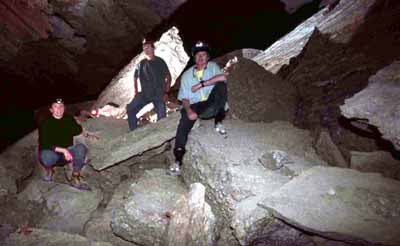 |
|
|
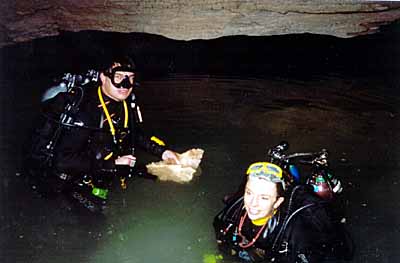 |
Upon arrival for the third time at the water’s edge, they started their equipment preparations. Greg mentioned that he wasn’t feeling at his best, on account of the long night of surveying ‘till 3 in the morning and the associated sleep deprivation, on top of the gear-lugging efforts. Greg was quite satisfied with the previous day’s dive efforts, and was very happy to give Arlene the chance to make a dive with his gear. Arlene was also pleased to have the opportunity to dive Dahl Hit again!
Greg and Shayne reviewed the equipment with Arlene and Shayne did some additional optimization of the first stage hose routing, to minimize vulnerability to cave ceiling contacts. Greg’s 5mm wetsuit proved a good fit for Arlene, but it also required about 20 lbs of weight to counter its buoyancy.
Shayne and Arlene set off across the shallow waters, submerged, and gradually their lights’ glow completely disappeared from view, as they passed beyond the tunnel.
Greg enjoyed the relaxing sensory deprivation in the silent pitch dark after the diver’s departure. Nearly 50 minutes later, a faint, eerie green glow appeared, followed by the blub-blub sound of bubbles surfacing. Greg grabbed his camera, and captured their enthused return.
They had a successful dive. Arlene stayed in the first room due to not being totally familiar with Greg’s equipment. Shayne proceeded on to the end of the permanent cave line. To explore further Shayne tied off a line to the end of the existing one and proceeded to a narrow passage on the right that appeared to continue on. Unfortunately the passage was too narrow to allow further penetration with the big steel twin tanks on his back. After trying to squeeze his way through belly deep in silt and tanks scraping on the ceiling, Shayne decided to turn around and go back with the thought of having to come back another day with a different gear configuration to see where this tunnel leads. The silt was all stirred up and visibility was zero for about 10 feet (3m). With conditions like this, orientation is impossible except for the line that Shayne had reeled out. Reeling his line back Shayne exited the siltout and stopped to brush the remaining silt from his wetsuit so as not to continue silting the cave. Upon returning to the first room where Arlene was patiently waiting, Shayne again tied off a line to explore to the left hand side of the room. This proved to be a dead end. After again reeling up his line, Shayne and Arlene exited the water.) Shayne was impressed by some of the huge calcite crystals which littered some portions of the cave.
He also mentioned seeing the small tracks left behind by 3 types of invertebrate cave dwellers, including an amphipod, and a long thin worm.
After drying off, the weary divers started packing up their gear for the long haul up and out of the cave. They had a tremendous amount of gear, their strength greatly depleted from the weekend’s activity, and an arduous effort ahead to return to the surface. As they were assessing their predicament, they heard the approach of a large group making their way towards the water. This was a party of one nurse (Debbie James) and seven US Servicemen from the nearby Al-Kharj Military Base who came visiting the Ain Hit area as part of a day-off fun tour of their base surroundings. Topside, Chris had sparked their adventurous spirit by mentioning that divers were exploring the deep reaches of the cave. They decided to modify their recreation plans, and to make a serious descent in the cave to go see for themselves what these divers were up to. Without Chris’s prompting, it is likely that this stalwart group would have turned around long before reaching the watery depths. After having a good look around, Debbie and the Servicemen readily volunteered to help lug the heavy gear back to the surface. Al Humdulahlah!! The divers could not have been more grateful and appreciative of their timely good fortune to be saved by the US Military, and a nurse, from enormous grief!
Around 3pm Greg & Arlene & finally Shayne, all trudge back, accompanied by the soldiers, loaded up with gear. They are exhausted and exhilarated. Photo shots all round, fluids replenished, emails traded, and the military group departs for their next adventure stop while there is still daylight.
|
|
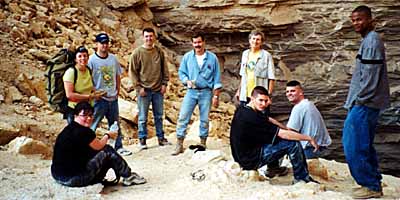 |
|
|
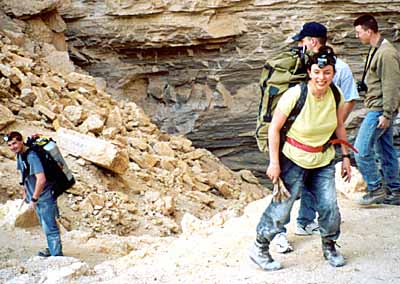 |
Shayne’s cuts and grazes are raw from the equipment chafing. More antibiotic cream. Everyone gets cleaned up and we have a bite to eat. The divers are greatly relieved that all has gone well, and that they had the critical return-haul help. They also start to notice how weary they are from their busy weekend. As dusk sets-in, we finish packing-up the vehicles and head away to Riyadh. Arlene guides us through the city to her residence where she parts company with us. A quick visit to the Willmotts and we’re on the road to Dammam by 6pm. It’s a tough and tiring drive back to Dhahran– plenty of stops to stretch and keep awake, and rate the ‘man toilates’ (Yes, that’s exactly how it was spelled!).
There’s talk already of a return trip to Ain Hit to further survey the underwater section, and changing to sidemount gear configuration, to permit easier access to the distant, narrower portions of the cave.
2/28/2003 12:25 AM